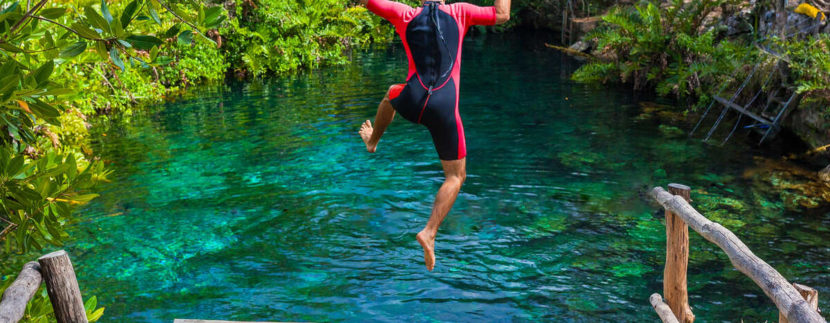Why Travelers Headed To Cancun Should Visit Cenotes Instead Of The Beach Right Now

[ad_1]
Cancun is America’s favorite sunny getaway, and it’s easy to see why. Straddling the Caribbean Coast of Mexico and home to an impressive array of five-star properties, it is a world-class destination deserving of all the hype.
If you’re heading to Cancun in the coming days or weeks, however, you may want to steer clear of the beaches and head instead to a cenote.

We know the white sands bounded by a turquoise-colored ocean is Cancun’s main attraction and that the Mayan Riviera is one of the most beautiful coastal strips in the world, but trust us when we say it’s always best to have a backup plan should any kind of disruption arise.
Including the arrival of foul-smelling algae:
Sargassum Has Arrived Early And In Record Numbers

Like many other locations around the Caribbean, Cancun – and the wider Riviera Maya – is blighted by sargassum seaweed every year between the months of April and October, when record amounts of the smelly brown algae wash ashore, tarnishing the normally-pristine beaches.
This year, the seaweed arrived much sooner – as early as February – and deposits have already started forming across various swimming spots along the Caribbean coast, including not only the Hotel Zone in Cancun but also Playa del Carmen, Tulum, and Puerto Morelos.
Top 5 Travel Insurance Plans For 2023 Starting At $10 Per Week

The algae itself does not present a health risk: albeit unpleasant, it is a natural phenomenon resulting from rising sea temperatures.
When the weather is hotter, sargassum tends to reproduce much faster and on a larger scale, affecting nearly all of Quintana Roo’s tourist spots.
Unlike Isla Mujeres, which sees very limited levels of algae making landfall, Cancun is not an exception, and despite the city’s best efforts to mitigate the problem, it is only getting worse with each passing year.
As noted above, ‘sargassum season’ began two months earlier than expected in 2023.

Luckily, the sea is not the only gorgeous natural wonder Americans vacationing in Mexico have easy access to: there is a literal underworld of cenotes and natural springs to discover, and with seaweed incidence rising, in spite of the cleaning taskforce, it’s no wonder cenote tours are exploding in popularity right now.
But first, what even are cenotes?
The Sacred Mayan Waterways

Cenotes is a regional term most commonly employed in the Yucatan Peninsula of Mexico, used in reference to natural sinkholes that were once held as sacred by the ancient Mayan peoples.
These freshwater lagoons are now open to the public and can be found in cave-like structures.
In Ancient Times, they were used for sacrificial offerings and provided clean water to the Mayan city-states.

It is estimated that the peninsula, which includes all of Quintana Roo and the neighboring states of Yucatan and Campeche, has over 10,000 cenotes, and several of those are visitor-friendly.
As reported by the Cancun Sun, local tour operators have noted cenote excursions are experiencing a sharp spike in bookings this year following the arrival of sargassum.
As they are bodies of fresh water, cenotes are not plagued by seaweed, and the turquoise hue of the waters remains unblemished year-round.
We must note not all cenotes are safe for visitation, as they may have higher levels of bacteria, or the caves may be off-limits:
The Safest Way To Explore A Cenote
@traveloffpath The cenotes at Tankah Park are dreamy 🥰 The perfect day trip during a Maya Luxe vacation 🔆 . #mayaluxe #travel #traveloffpath #fyp #foryoupage #traveler #mexico🇲🇽 #mexico #rivieramaya #vacation #cenote #cenotes ♬ sonido original – Travel Off Path
For that reason, it is paramount that cenote tours are booked through reputable companies. When staying in a resort in downtown Cancun, contacting the concierge regarding authorized tour operators is the best and safest way to visit a cenote.
Alternatively, you may book a cenote tour via one of the top-rated providers on Viatur: the Cancun Combo Tour, which features cenote swimming in Yax-Muul, has prices starting from only USD $99,00 and an impressive list of inclusions, such as a ‘light lunch’, ziplining, and a ride through the jungle.

Yet another option is the Viator Exclusive Combo Tour, which couples a visit to the world-famous Tulum ruins with a cenote visit. More specifically, the Xtun Cenote, where the waters are a pearly blue and stalactites hang from the roof. Prices for this one start at USD $109.
The most popular area for cenote tours is the Ruta de los Cenotes, within driving distance of Puerto Morelos, where the caves have been given the all-clear for tourism, dotted with four different types of sinkholes, both open-air and enclosed.
Once again, we must remind you some of these underwater caves and natural pools can be tricky to navigate.

Sargassum is most definitely not a concern, but the structure may be prone to collapsing, or some of the pools may harbor life-threatening bacteria.
In order to avoid unnecessary health risks, and ensure you steer clear of danger, check the relevant warnings for cenotes in the area, contact a tour guide, and never attempt to explore an unlisted cave chamber by yourself.
Traveler Alert: Don’t Forget Travel Insurance For Your Next Trip!
↓ Join Our Community ↓
The Travel Off Path Community FB group has all the latest reopening news, conversations, and Q&A’s happening daily!

SUBSCRIBE TO OUR LATEST POSTS
Enter your email address to subscribe to Travel Off Path’s latest breaking travel news, straight to your inbox
This article originally appeared on TravelOffPath.com
[ad_2]
Source link






